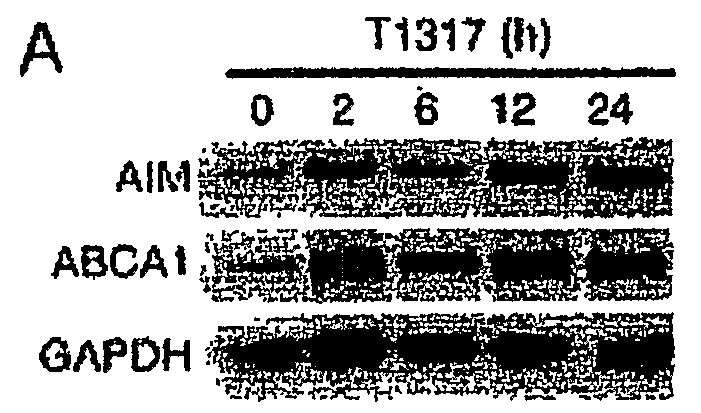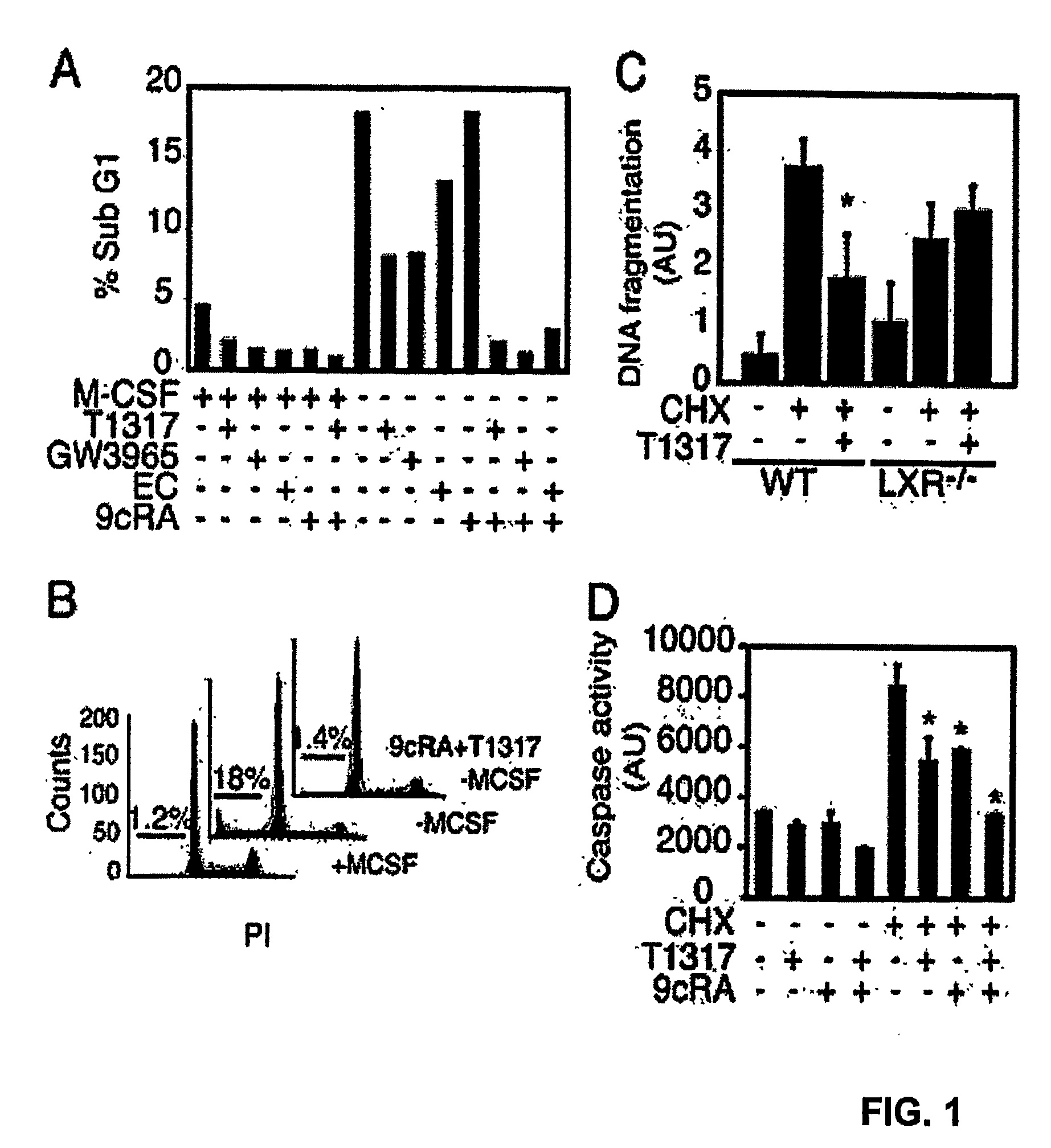Compounds that Prevent Macrophage Apoptosis and Uses Thereof
a macrophage cell and apoptosis technology, applied in the field of microbial infection, can solve the problems of pathogenic bacteria populations shifting towards refractory strains, and the effectiveness of pathogens is now increasingly ineffective, so as to increase the activity of liver x receptors, and reduce the expression of proteins
- Summary
- Abstract
- Description
- Claims
- Application Information
AI Technical Summary
Benefits of technology
Problems solved by technology
Method used
Image
Examples
example 1
Materials And Methods
[0147]The following is a description of exemplary materials and methods that were used in subsequent examples.
[0148]Reagents: It is not intended to limit the source of reagents. In one embodiment, reagents were obtained by donations (for example, T1317 and GW3965 was donated by X-ceptor Therapeutics, Inc., San Diego, Calif.). In one embodiment, reagents were obtained from commercial sources. Anisomycin of Streptomyces griseolus and SB202190 were purchased from Calbiochem (San Diego, Calif.). Cycloheximide of Staphylococcus griseus, 9 cis-retinoic acid and lipopolysaccharide (LPS) were obtained from Sigma (St. Louis, Mo.). 24(S),25-epoxycholesterol (EC) was purchased from BIOMOL Research Laboratories, Inc. (Plymouth Meeting, Pa.). Small interfering RNA (siRNA) was obtained from Ambion (Austin, Tex.).
[0149]Sources of mice: It is not intended to limit the source of mice. In one embodiment, mice were obtained by personal donations (for example, LXR− / − mice were obta...
example 2
LXR and RXR Agonists Inhibit Apoptotic Responses
To Growth Factor Withdrawal and Protein Synthesis Inhibition
[0156]This example details the demonstration that LXR activation inhibits macrophage apoptosis. The inventor's discovered that treatment of bone marrow-derived macrophages (BMDMs) with LXR agonists improved their survival in the setting of growth factor withdrawal. Therefore the inventor's investigated potential roles of LXRs in regulation of macrophage apoptosis. Culturing BMDMs for 36 h in the absence of their specific growth factor (macrophage-colony stimulating factor, M-CSF) resulted in increased levels of cells with sub-G1 DNA content, an indicator of apoptosis-induced DNA fragmentation (FIG. 1a,b). This process was attenuated when macrophages were pre-incubated with the synthetic LXR agonists T1317 or GW3965 or the natural agonist 24(S), 25-epoxycholesterol (EC). 9 cis-retinoid acid (9cRA), a ligand for the RXR heterodimeric partner of LXRs, had little effect on sub-G1 ...
example 3
LXR And RXR Activation Protects Macrophages from Pathogen-Induced Apoptosis
[0159]This example details the demonstration that LXR and RXR promote macrophage survival in the face of bacterial infection. Recent studies have identified the p38MAPK (p38 mitogen-activated protein kinase) pathway as a target for the action of lethal factor, a virulence determinant from Bacillus anthracis (Park et al. (2002) Science 297, 2048-51). Inhibition of the p38MAPK cascade sensitizes macrophages to programmed cell death in response to activation of TLR4 (Hsu et al. (2004) Nature 428, 341-5; Park et al. (2002) Science 297, 2048-51). Treatment of BMDMs with LXR and RXR agonists resulted in decreased levels of annexin V staining after the combined incubation with LPS and the p38 inhibitor SB202190 (FIG. 2a,b). The inventor's evaluated the possibility that LXR and RXR agonists could protect macrophages from apoptosis due to infection with B. anthracis and other bacterial pathogens. Indeed, preincubation...
PUM
| Property | Measurement | Unit |
|---|---|---|
| molecular weight | aaaaa | aaaaa |
| densities | aaaaa | aaaaa |
| apoptosis reduction potential | aaaaa | aaaaa |
Abstract
Description
Claims
Application Information
 Login to View More
Login to View More - R&D
- Intellectual Property
- Life Sciences
- Materials
- Tech Scout
- Unparalleled Data Quality
- Higher Quality Content
- 60% Fewer Hallucinations
Browse by: Latest US Patents, China's latest patents, Technical Efficacy Thesaurus, Application Domain, Technology Topic, Popular Technical Reports.
© 2025 PatSnap. All rights reserved.Legal|Privacy policy|Modern Slavery Act Transparency Statement|Sitemap|About US| Contact US: help@patsnap.com



